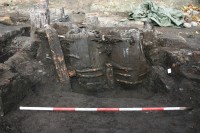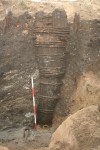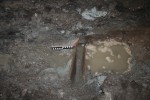 Archaeologists excavating I. Vilhelm Werners Square in Hans Christian Andersen’s hometown of Odense, Denmark, are delighted to have found barrels full of medieval excrement. Poop is a boon to modern archaeology because it can tell us more about the daily lives of past people than golden treasures, and this particular poop is very well preserved thanks to having been buried in an oxygen-poor environment.
Archaeologists excavating I. Vilhelm Werners Square in Hans Christian Andersen’s hometown of Odense, Denmark, are delighted to have found barrels full of medieval excrement. Poop is a boon to modern archaeology because it can tell us more about the daily lives of past people than golden treasures, and this particular poop is very well preserved thanks to having been buried in an oxygen-poor environment.
 The content of the barrels was immediately identifiable from the odor which was still pungent after 700 years in barrels under layers of the city. The first round of analysis found that 14th century Odensians were fans of raspberries, as well they should be. Scientists also found fragments of moss, leather and fabric all of which are thought to have been used as toilet paper. (Moss toilet paper? Would it have been, like, a clump attached to soil? How does it stay intact otherwise? Because if the structural integrity issue was dealt with, I imagine moss would make a pretty comfortable tp.)
The content of the barrels was immediately identifiable from the odor which was still pungent after 700 years in barrels under layers of the city. The first round of analysis found that 14th century Odensians were fans of raspberries, as well they should be. Scientists also found fragments of moss, leather and fabric all of which are thought to have been used as toilet paper. (Moss toilet paper? Would it have been, like, a clump attached to soil? How does it stay intact otherwise? Because if the structural integrity issue was dealt with, I imagine moss would make a pretty comfortable tp.)
Markings on the barrels indicate that they were not initially used as latrines. An anchor carved on one suggests it was used to transport or store herring, a major source of trade for medieval Odense. The barrels themselves are generally in good condition, which makes sense because you wouldn’t want to recycle a busted barrel for use as a cesspit. Containment is key to sewage management.
 The poop barrels were unearthed last year. Continuing excavations on the site this year discovered even more barrels in an unusual configuration. Three barrels were stacked on top of each other and strapped together with strong wicker. At the base of the pit archaeologists found a mat of reeds and a pipe system made of recycled roof tiles. It seems this was a homemade water well, with the pipes used to draw water into the barrel well and the reed mat as a filter to keep sludge out of the water. On each side of the barrel stack are the remains of pillars, probably used to hold aloft a small roof to project the well water from bird poop or leaves or any other such contaminants.
The poop barrels were unearthed last year. Continuing excavations on the site this year discovered even more barrels in an unusual configuration. Three barrels were stacked on top of each other and strapped together with strong wicker. At the base of the pit archaeologists found a mat of reeds and a pipe system made of recycled roof tiles. It seems this was a homemade water well, with the pipes used to draw water into the barrel well and the reed mat as a filter to keep sludge out of the water. On each side of the barrel stack are the remains of pillars, probably used to hold aloft a small roof to project the well water from bird poop or leaves or any other such contaminants.
 The well is also from the 1300s and may have originally been in the courtyard of a home. It could also have been part of a beer brewing apparatus. Near the well archaeologists found a store of partially germinated barley, a key supply for beer making.
The well is also from the 1300s and may have originally been in the courtyard of a home. It could also have been part of a beer brewing apparatus. Near the well archaeologists found a store of partially germinated barley, a key supply for beer making.
The Werners Square area is thought to be the oldest area in Odense, settled from at least the 11th century, and possibly as early as 988 when historical sources claim a bishopric was established there. The first recorded bishop, Reginbert, was sent to Odense by King Canute the Great in 1020 or 1022. The excavation, which began in 2013, hopes to reveal the earliest days of Odense going back to King Canute’s day. Preliminary studies found the remains of one of the oldest datable streets from around 1100.
The dig, which is the largest in the city’s history, is open to visitors every Tuesday and Thursday at 1:00 PM. The archaeologists’ workshop is also open to visitors on Tuesdays, Wednesdays and Thursdays from noon to 3:00 PM. I wonder if there were visitors present when the fragrant poop barrels were discovered.